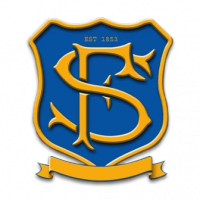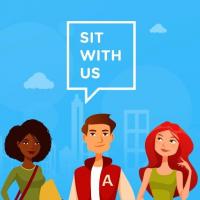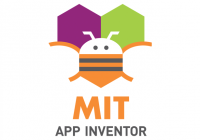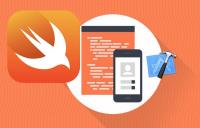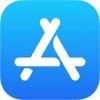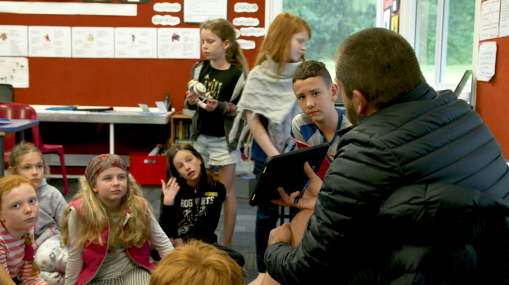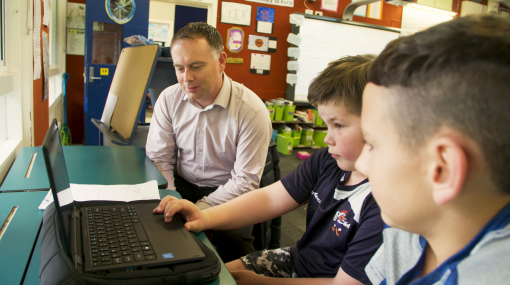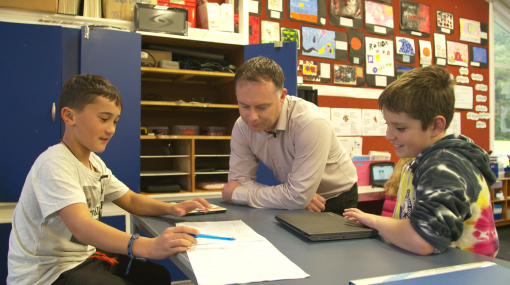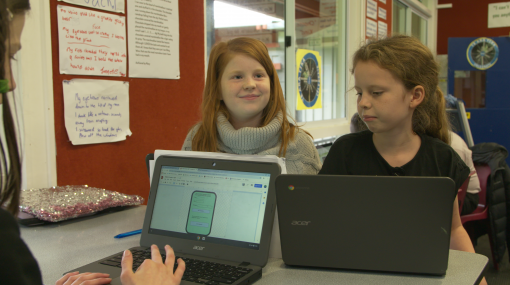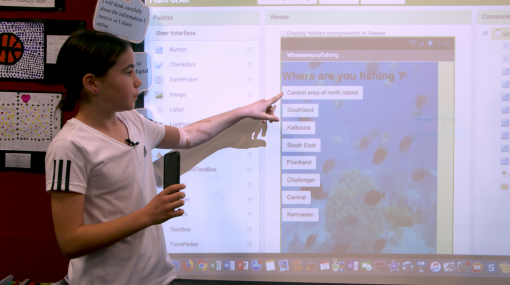App development in the classroom
When students make apps, they learn:
- valuable STEAM skills like coding, programming, graphic design, and content creation
- how to solve real-world problems with digital design.
Whether tackling challenges at school, within the community, or even on a global scale – knowing how to build apps empowers students to meaningfully change their environment through technological intervention.
Frankley School students design apps to solve problems in the community.
What kinds of apps are students making at school?
Just like the diverse range of apps available in your smartphone's app store, students are making apps that vary in purpose and audience.
Apps for tackling social and environmental challenges
One of the most powerful aspects of an app is its ability to reach a large audience quickly and efficiently. Millions of people are using smartphone apps everyday. This means that even the broadest social issues or needs can be addressed by well-conceived apps.
This stuff article features primary school students from Frankley school, who developed apps to:
- educate about bullying
- help fisherman stay within catch-size regulations
- help trampers stay safe in the bush.
Apps for solving local problems
A great place to start problem-solving is where your students are most familiar. Encourage them to think about problem-solving within their own personal contexts – at school, at home, or in the community.
This app, created by 16-year-old Natalie Hampton from Sherman Oaks, California, was designed to make her school a more inclusive experience for new students.
Built specifically for the lunchroom, SIT WITH US allows users to host open lunch tables, inviting anyone in need of companionship to join. The app aims to combat loneliness and bullying.
Apps for educating
When learners are engaged and passionate, they naturally want to share what they've learnt with others. Developing an app can be an effective way of sharing knowledge and expertise with a wider audience. xxxxxxxxx
Three US high school students built the Elements app to help their classmates who were struggling to remember the periodic table. They included a text-to-speech feature for users who are visually impaired.
Apps for business
Instil the entrepreneurial spirit at an early age by exploring the commercial possibilities of apps with your students.
William J. Johnston Middle School sixth-grade students Chloe Alfieri and Taylor Ruitto developed an app for the school’s cafeteria , complete with menus, prices, and recycling information.
The app was made simply using Google Slides.
Apps for entertaining
Not every app has to change the world. Many apps have value because they make you laugh, surprise you, or keep you fighting to get to the next level.
MIT App Inventor's app of the month winners
Take a look at this gallery of winning apps invented by school students and other amateur developers.
MAD-learn's mobile app development course gives school students the chance to create an app from beginning to end. Check out their own "App Store" for previews of student-made apps.
Benefits for student learning
Students who develop apps:
- have increased interest and awareness of opportunities in STEAM areas
- are empowered to succeed in computer science
- have creative outlets to demonstrate their competence in STEAM skills
- learn social entrepreneurship
- learn how to work in a team
- gain self-confidence.
Brendon Anderson explains how Frankley School students bring real-world business roles into their classroom.
More information »
The impact of student-created apps
Teacher Vicki Davis writes about why making apps has been transformative and empowering for her students.
Developing an app is a creative process, and like all creative endeavours, there is no right or wrong way to go about it.
Ideating and planning
Before launching into programming, it is a good idea to do some broader thinking with your students about:
- what apps are
- who makes them
- their purpose, or why they are made.
Wireframes
Pre-planning your app using a wireframe helps make the development process a much smoother and clearer process.
A wireframe is a visual guide that represents the structure and frame of an app or website. Also known as a screen blueprint, a wireframe:
- organises the elements of an app (content, buttons, headings etc.) into a hierarchy before coding and development begins
- makes the actual app-building process clearer
- is helpful for generating ideas
- can be both hand-drawn or designed using digital tools.
Frankley school students use digital and paper wireframes to plan their mobile apps.
Wireframing tools
The definitive guide: How to create your first wireframe – Career foundry's guide has video tutorials for wireframing as well as helpful tips.
Gives you the ability to make quick wireframes directly onto your browser. Has a free version, but paid subscriptions give more functionality.
This is a cloud-based, collaborative, whiteboard-style wireframe tool. Good for quick, team-based mockups of a new app. Completely free to use.
Often considered as the best wireframe tool for beginners. Paid subscription only.
Identify which tool will work for you and your students
The 14 best wireframe tools for 2019 – Maria Myre gives a breakdown of the pros and cons of various wireframe tools.
Learning approaches
There are several learning approaches that could inform your thinking around an app development project, such as learner inquiry or project-based learning.
Approaches specifically supporting student-driven technological invention
Design thinking
Design thinking is an iterative process that provides a solution-based approach to solving problems.
At the core of design thinking is the intention to improve products by analysing and understanding how users interact with them and investigating the conditions in which they operate.
Design thinking could be a helpful approach to use when creating a new app.
STEAM learning
STEAM is the application of content from science, technology, engineering, art, and maths to solving real-world problems through hands-on learning activities.
Consider how developing an app could become a meaningful STEAM project by integrating concepts from across learning areas.
Makerspaces
Developing an app could be the best way to resolve a makerspace project. Think about how an app could interface with a robot, device, or invention that has been made in a makerspace.
Frankley School students share their passion for coding.
Linking to the curriculum
Using app development as a context for learning in your classroom, you can explore the technological areas – in particular:
- digital technologies
- computational thinking for digital technologies
- designing and developing digital outcomes
- design and visual communication
Think about how developing an app can be integrated across different curriculum learning areas and support students' digital literacy.
Choosing a development path
Developing an app can be a challenging task. There are multiple pathways to developing a completed, usable app. Each approach requires a certain amount of learning, technical knowledge, and expertise. Different programming tools and languages present different advantages and challenges.
Considerations before beginning a project
Your learning goals
What is your learning goal? To make a creative app? To learn coding, programming, and computational thinking along the way?
- A wholistic app development course using a programming tool like MIT App Inventor, or a native programming language like Swift (iOS) or Java (Android), could be the way forward. This approach will require considerable time and investment from you and your students.
- If you want an app built to solve a learning problem unrelated to coding and programming – completed quickly – then using a DIY app-builder could be an option.
- Think about your learning goals and plan accordingly.
Your student profile
What age are your students? What are their learning needs? What prior knowledge of coding and programming do they have?
- If dealing with young learners totally new to coding, MIT App Inventor could be the best platform, as it is accessible for young learners.
- If your students are older and have some prior knowledge of coding, developing an app using a native programming language like Swift could be an appropriate challenge.
Access to devices
What devices are readily available to your students? How will they test the programming they have made?
- If your students have access to Apple devices, then coding in Apple's native programming language, Swift, could be the way forward.
- If your students have access to Android devices, then programming with Android-compatible coding tools like MIT App Inventor are options.
- If your students need the apps to work across multiple devices, then coding web-based apps using JavaScript or HTML5 could be the approach to take.
Finding a mentor
Programming an app is doable in a classroom environment, but having an app industry expert come in to mentor can be beneficial for students.
Mentors:
- Can advise students on best practise and standard approaches for coding
- Provide advice during the planning and design stages of an app
- Give students insights into real jobs in tech.
David Fox, software developer, talks about his mentoring role with Frankley School.
Voluntarily
Voluntarily is an online app that connects schools with corporate volunteers and short technology course content.
Programming and coding your app
There are a number of app development pathways to choose from, each using different tools and programming languages, each with different purposes and functionality.
Below are two pathways that have been selected as viable options for those new to programming. They have been selected because of their approachability for newcomers as well as availability of teaching resources. Consider which approach will be best for your learners.
MIT App Inventor - For Android apps
MIT App Inventor is a free, browser-based development tool designed to enable people of all ages and levels of coding experience to learn the basics of programming.
Like MIT's popular coding-teaching tool – Scratch – App Inventor features a visually organised, block-style, drag-and-drop coding interface. It gives newcomers to programming the opportunity to program without prior knowledge of any of the programming languages.
- App Inventor allows for the programming of apps for android devices only.
- It enables users to creatively customise the functions of an android phone like location, SMS texting, the camera, speakers, video and more.
- App Inventor is often an entry point for school-age newcomers to programming and app development.
- It has easy-to-follow tutorials and beginner guides that can be found on its official website.
- Many of the tutorials have been designed for primary school-age students.
- It has a dedicated community forum for troubleshooting and knowledge-sharing.
Developing android apps with App Inventor
This free online course hosted by Coursera was created to teach the basics of programming in MIT App Inventor.
Publishing your MIT App Inventor app on the MIT app inventor gallery
Your app can be published in the MIT App Inventor gallery, which will give you a URL to share with others, who can download and use your app.
Publishing your app onto the Google Play store
You can also potentially publish your app on Google Play and share it with the wider android market. See here for the steps involved in getting your app published
.
Swift - For iOS apps
Swift is the native language for iOS app development – it is used by programmers to develop Apple products. It is new, open source, intuitive, and gaining currency as Apple's primary programming language. Students can code in Swift to develop mobile apps for Apple devices.
In recent years, there has been a big push from Apple to make Swift accessible to newcomers to programming.
Resources to help educators teach Swift coding and app development
Swift playgrounds
Swift Playgrounds is a game-like app that makes learning Swift interactive and fun. It requires no coding knowledge.
For more on how to include Swift Playgrounds into a course that teaches computational thinking as well as swift coding, see Swift Playgrounds curriculum guide
App Development with Swift curriculum guide
The Intro to App Development with Swift and App Development with Swift curriculums were designed to teach high school and university students with little or no programming experience how to be app developers, capable of bringing their own ideas to life.
Publishing your app to the iOS App Store
Publishing an app onto the App Store requires a number of steps, including meeting Apple's App Store guidelines. All apps are tested before submission, and many apps are rejected if they are not compliant with the guidelines or contain any bugs or crashes. You also need to register as a member of Apple's app developer program, which costs $99 per year. Educational institutions could be eligible for a fee waiver.
No-code DIY app builders
If you want to make an app, but do not have time to learn programming and coding, there are several web-based app-builder services that allow you to quickly put an app together using drag-and-drop editing tools. Each action you make auto-generates the development code.
Advantages of no-code app builders
- They offer an expedient way to resolve a problem requiring an app-based solution.
- Drag-and-drop editing tools can make the process of building an app fun and easy.
Disadvantages of no-code app builders
- They restrict users to the functions they offer, which can be specific and limited. This is unlike coding your own app, which gives you more freedom, flexibility, and creativity.
- There is no guarantee that an app created in an app-builder can fulfil the requirements for publishing on an app store.
- They often require payment.
Do your research before choosing a service.
Mobincube
Mobincube enables users to create a range of apps, from business to educational, entertainment to games. Teachers and students have full unlimited access to most of the premium services of Mobincube for free.
AppyPie
AppyPie contains a number of app templates and features. It has as a free option with limited functionality, with paid options that include more features.
Snapshot of learning
App development at Frankley School
Students at Frankley school design and program their own mobile apps to solve problems in the community.
Filter by: Primary
Sorry, no items found.
Readings
The impact of student-created apps
Teacher Vicki Davis writes about why making apps has been transformative and empowering for her students.
Student-made apps
Students at Frankley School in New Plymouth have produced three apps that have potential to go global
This stuff article features primary school students from Frankley school.
SIT WITH US
This app, created by 16-year-old Natalie Hampton from Sherman Oaks, California, was designed to make her school a more inclusive experience for new students.
Elements app
Three US high school students built the Elements app to help their classmates who were struggling to remember the periodic table. They included a TextToSpeech feature for users who are visually impaired.
MIT App Inventor's app of the month winners
Take a look at this gallery of winning apps invented by school students and other amateur developers.
MAD-learn
MAD-learn's mobile app development course gives school students the chance to create an app from beginning to end. Check out their very own "App Store" for previews of student-made apps.
Wireframing
The definitive guide: How to create your first wireframe
Career foundry's guide has video tutorials for wireframing as well as helpful tips.
The 14 best wireframe tools for 2019
Maria Myre gives a breakdown of the pros and cons of various wireframe tools.
Wireframing tools
Wireframe.cc
Gives you the ability to make quick wireframes directly onto your browser. Has a free version, but paid subscriptions give more functionality.
InVision freehand
This is a cloud-based, collaborative, whiteboard-style wireframe tool. Good for quick, team-based mockups of a new app. Completely free to use.
Balsamiq
Often considered as the best wireframe tool for beginners. Paid subscription only.
Programming and development tools and pathways
MIT App Inventor - For Android apps
MIT App Inventor is a free, browser-based development tool designed to enable people of all ages and levels of coding experience to learn the basics of programming.
Developing android apps with App Inventor
This free online course hosted by Coursera was created to teach the basics of programming in MIT App Inventor.
Publishing your MIT App Inventor app on the MIT app inventor gallery
Your app can be published in the MIT App Inventor gallery, which will give you a URL to share with others, who can download and use your app.
Swift - For iOS apps
Swift is the native language for iOS app development – it is used by programmers to develop Apple products.
Swift playgrounds
Swift Playgrounds is a game-like app that makes learning Swift interactive and fun. It requires no coding knowledge.
For more on how to include Swift Playgrounds into a course that teaches computational thinking as well as swift coding, see Swift Playgrounds curriculum guide
.
App Development with Swift curriculum guide
The Intro to App Development with Swift and App Development with Swift curriculums were designed to teach high school and university students with little or no programming experience how to be app developers, capable of bringing their own ideas to life.
DIY app builders
Mobincube
Mobincube enables users to create a range of apps, from business to educational, entertainment to games. Teachers and students have full unlimited access to most of the premium services of Mobincube for free.
AppyPie
AppyPie contains a number of app templates and features. It has as a free option with limited functionality, with paid options that include more features.
